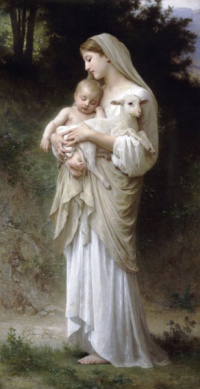Innocence (Bouguereau)
From The Art and Popular Culture Encyclopedia
(Difference between revisions)
| Revision as of 19:05, 29 April 2010 Jahsonic (Talk | contribs) ← Previous diff |
Revision as of 18:16, 6 January 2019 Jahsonic (Talk | contribs) Next diff → |
||
| Line 1: | Line 1: | ||
| - | [[Image:Bouguereau Innocence.jpg|thumb|200px|''[[Innocence (Bouguereau)]]'' ([[1893]]) by [[William-Adolphe Bouguereau]]: Both young [[children]] and [[lamb]]s are symbols of innocence. An allegory on [[innate goodness]].]] | + | [[Image:Bouguereau Innocence.jpg|thumb|200px|''[[Innocence (Bouguereau)|Innocence]]'' ([[1893]]) by [[William-Adolphe Bouguereau]]: Both young [[children]] and [[lamb]]s are [[symbol]]s of [[innocence]]]] |
| {{Template}} | {{Template}} | ||
| + | ''[[Innocence (Bouguereau)|Innocence]]'' (1893) is a painting by [[William-Adolphe Bouguereau]]. It depicts a woman who is holding a [[child]] and a [[lamb]]. | ||
| {{GFDL}} | {{GFDL}} | ||
Revision as of 18:16, 6 January 2019
|
Related e |
|
Featured: |
Innocence (1893) is a painting by William-Adolphe Bouguereau. It depicts a woman who is holding a child and a lamb.
Unless indicated otherwise, the text in this article is either based on Wikipedia article "Innocence (Bouguereau)" or another language Wikipedia page thereof used under the terms of the GNU Free Documentation License; or on research by Jahsonic and friends. See Art and Popular Culture's copyright notice.


